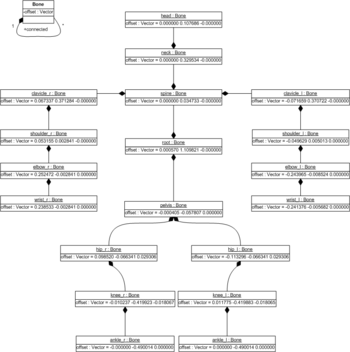Pedestrian skeleton
The parts of a pedestrian model are bound to a skeleton. A skeleton is constructed by a number of bones that are attached with joints. In MM2 the skeletons are defined using a tree structure.
The format
First comes a parameter defining the number of bones, or actually joints, the skeleton is made of:
- NumBones <int>
Then follows the tree of bones, starting with a root bone that represents the origin of the character. Each bone starts with:
- bone <name> {
Where name is a string, without whitespace, naming the bone. Each bone ends with: - }
Between these comes, first an offset and then a list of bones attached to the current bone. The offset is on this format:
- offset <float> <float> <float>
Where the floats are the x, y and z of a translation relative to the parent bone.
The list of bones is just new bone definitions after each other, with no separators except whitespace.
When rendering a pedestrian model, each vertex has to be modified according to the bone it is connected to. For example, if we have a skeleton that looks like this:
NumBones 3
bone root {
offset 0.000570 1.109821 -0.000000
bone spine {
offset 0.000000 0.034733 -0.000000
bone neck {
offset 0.000000 0.329534 -0.000000
bone head {
offset 0.000000 0.107686 -0.000000
}
}
}
}
And we want to render the faces connected to the head, each vertex has to be translated by four offsets. First the offset of the root bone, then the offset of the spine bone, then the neck bone and at last the head bone. So, to get the final location of each point, the skeleton tree has to be traversed from the root to the bone that the face is attached to. Fortunately translations are commutative operations, a + b = b + a, so you can traverse the tree from the connected bone and back to the root instead. This is easier to implement. An even more effective way to render would be to construct a single transformation matrix for each bone at load time. Then we only have to apply one translation for each vertex.
